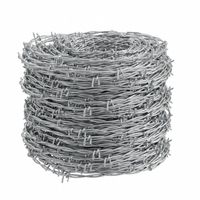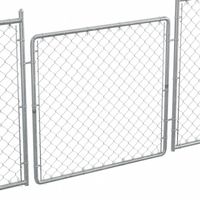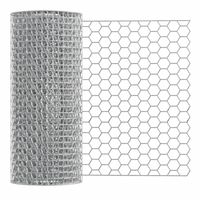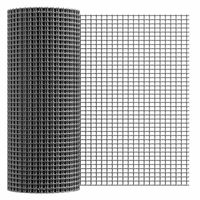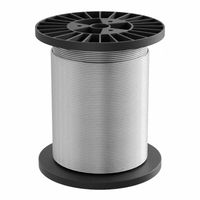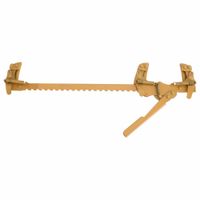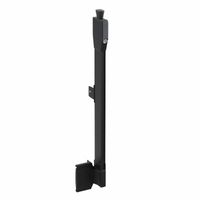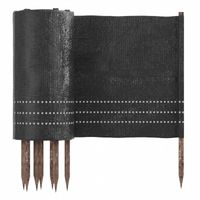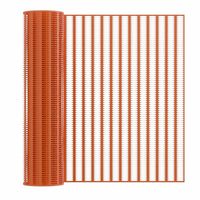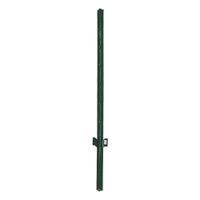Call +(254) 703 030 000 / 751 483 999 / 721 704 777
- Home
- Outdoor Equipment
- Fencing
.....Read More
Frequently Asked Questions
What are the different types of fencing materials used for agricultural fields?
1. **Barbed Wire**: Made of twisted strands of wire with barbs at regular intervals, barbed wire is cost-effective and widely used for livestock containment.
2. **Woven Wire**: This type of fencing consists of horizontal and vertical wires woven together to form a grid. It is ideal for keeping smaller animals in or out and is often used in combination with barbed wire.
3. **Electric Fencing**: Comprising wires that carry an electric charge, this fencing type provides a psychological barrier for animals. It is versatile and can be used for both temporary and permanent fencing.
4. **High-Tensile Wire**: Made from high-carbon steel, high-tensile wire is strong and durable. It can be electrified and is suitable for long stretches of fencing.
5. **Wooden Fencing**: Traditional and aesthetically pleasing, wooden fences are sturdy and effective for livestock. They require regular maintenance to prevent rot and damage.
6. **Vinyl Fencing**: Made from PVC, vinyl fencing is durable, low-maintenance, and resistant to weathering. It is more expensive but offers a long lifespan.
7. **Chain Link Fencing**: Composed of interwoven steel wires, chain link fencing is durable and provides a clear view. It is often used for perimeter fencing.
8. **Mesh Wire Fencing**: Similar to woven wire but with smaller openings, mesh wire fencing is used for keeping small animals in or out and is often used in poultry farming.
9. **Composite Fencing**: Made from a mix of wood fibers and plastic, composite fencing is durable and low-maintenance, offering the appearance of wood without the upkeep.
10. **Hedge or Natural Fencing**: Using living plants, such as hedges or trees, this type of fencing provides a natural barrier and can enhance biodiversity.
11. **Stone or Brick Fencing**: Durable and long-lasting, stone or brick fences are used for permanent boundaries and offer excellent protection against larger animals.
How does chicken wire differ from other types of fencing?
Chicken wire, also known as poultry netting, is a type of wire mesh made from thin, flexible, galvanized steel wire with hexagonal gaps. It is distinct from other types of fencing in several ways:
1. **Material and Construction**: Chicken wire is typically made from galvanized steel, which provides resistance to rust and corrosion. The wire is woven into a hexagonal pattern, which offers flexibility and strength while being lightweight.
2. **Purpose**: Primarily designed to confine poultry, chicken wire is used to create enclosures that prevent chickens and other small animals from escaping while keeping predators out. It is not intended for heavy-duty security or privacy.
3. **Mesh Size**: The hexagonal openings in chicken wire are usually small, ranging from 1/2 inch to 2 inches in diameter. This size is effective for containing small animals and birds, unlike larger mesh sizes found in other fencing types.
4. **Flexibility and Ease of Installation**: Chicken wire is highly flexible, making it easy to shape and install around irregular areas. It can be cut with simple tools and attached to posts or frames with staples or ties, unlike more rigid fencing options like chain link or wooden fences.
5. **Cost**: Chicken wire is generally more affordable than other fencing materials such as wood, vinyl, or chain link, making it a cost-effective solution for temporary or small-scale enclosures.
6. **Durability**: While chicken wire is suitable for light-duty applications, it is not as durable or strong as other fencing types like welded wire or chain link, which are designed to withstand greater force and provide enhanced security.
7. **Aesthetic and Visibility**: Chicken wire is less obtrusive visually, offering minimal obstruction to views, unlike solid fences. However, it does not provide privacy or significant aesthetic value.
These characteristics make chicken wire ideal for specific applications, particularly in agricultural and garden settings, where its lightweight, flexible, and cost-effective nature is advantageous.
What is the purpose of a silt fence at construction sites?
A silt fence is a temporary sediment control device used at construction sites to protect water quality in nearby streams, rivers, lakes, and other bodies of water from sediment (loose soil) in stormwater runoff. The primary purpose of a silt fence is to prevent soil erosion and sedimentation, which can have detrimental effects on aquatic ecosystems and water quality.
Silt fences are typically made of a geotextile fabric stretched between a series of wooden or metal stakes. They are installed along the contour of the land, usually at the perimeter of a construction site or in areas where water runoff is expected. The fabric is designed to allow water to pass through while trapping sediment particles, thus reducing the amount of sediment that leaves the site.
By controlling sediment runoff, silt fences help to:
1. **Protect Water Quality**: Sediment can carry pollutants such as nutrients, heavy metals, and pesticides, which can degrade water quality and harm aquatic life.
2. **Prevent Soil Erosion**: By trapping sediment, silt fences help to stabilize the soil and prevent further erosion, which can lead to loss of fertile topsoil and increased sedimentation in water bodies.
3. **Comply with Regulations**: Many jurisdictions require the use of silt fences as part of erosion and sediment control plans to comply with environmental regulations and avoid fines or legal action.
4. **Minimize Environmental Impact**: By reducing sedimentation, silt fences help to maintain the natural flow and habitat of water bodies, supporting biodiversity and ecosystem health.
Overall, silt fences are a cost-effective and efficient method for managing sediment control at construction sites, contributing to sustainable construction practices and environmental protection.
How does barbed wire enhance security on fence lines?
Barbed wire enhances security on fence lines by serving as a physical and psychological deterrent. Its sharp barbs are designed to inflict discomfort or injury, discouraging unauthorized individuals from attempting to climb or cut through the fence. This physical barrier is difficult to bypass without specialized tools, making it an effective first line of defense.
The presence of barbed wire also acts as a psychological deterrent. Potential intruders are less likely to attempt breaching a fence topped with barbed wire due to the increased risk of injury and the time required to navigate it, which raises the likelihood of detection. This psychological impact is often enough to deter opportunistic trespassers.
Barbed wire is cost-effective and easy to install, making it a popular choice for enhancing security. It can be added to existing fences or used to create standalone barriers. Its versatility allows it to be used in various configurations, such as concertina wire or razor wire, to increase its effectiveness.
Additionally, barbed wire can be integrated with other security measures, such as surveillance cameras and motion sensors, to create a comprehensive security system. This integration enhances the overall security posture by providing multiple layers of protection.
In summary, barbed wire enhances security on fence lines by providing a robust physical barrier, serving as a psychological deterrent, being cost-effective and versatile, and complementing other security measures.
What are the benefits of using an electric fence?
Electric fences offer several benefits, including:
1. **Cost-Effectiveness**: They are generally cheaper to install and maintain compared to traditional fencing options. The materials required are less expensive, and the installation process is simpler.
2. **Flexibility**: Electric fences can be easily adjusted and relocated, making them ideal for temporary setups or changing pasture boundaries.
3. **Deterrence**: The mild shock delivered by an electric fence acts as a strong deterrent for animals, preventing them from attempting to breach the boundary. This is effective for both keeping livestock in and keeping predators out.
4. **Minimal Physical Barrier**: Unlike traditional fences, electric fences require fewer physical materials, which means they are less obtrusive and can blend more naturally into the landscape.
5. **Reduced Animal Injury**: The psychological barrier created by the electric shock reduces the likelihood of animals injuring themselves by trying to force through or over the fence.
6. **Versatility**: Electric fences can be used for a variety of animals, from small pets to large livestock, and can be adapted for different terrains and environments.
7. **Low Maintenance**: Once installed, electric fences require minimal upkeep. Regular checks for vegetation interference and battery or solar panel maintenance are usually sufficient.
8. **Energy Efficiency**: Modern electric fences can be powered by solar panels, making them energy-efficient and environmentally friendly.
9. **Enhanced Security**: For property owners, electric fences can provide an additional layer of security against intruders, as the shock serves as a deterrent.
10. **Wildlife Management**: They can be used to manage wildlife movement, protecting crops and reducing human-wildlife conflict.
Overall, electric fences offer a practical, efficient, and humane solution for managing animal movement and enhancing property security.
How is smooth wire used in fencing applications?
Smooth wire is commonly used in fencing applications for its versatility, cost-effectiveness, and ease of installation. Unlike barbed wire, smooth wire lacks sharp barbs, making it a safer option for containing animals without causing injury. It is often used in agricultural settings to create boundaries for livestock such as horses, cattle, and sheep.
The wire is typically made from galvanized steel, which provides durability and resistance to rust and corrosion, ensuring a long lifespan even in harsh weather conditions. Smooth wire is available in various gauges, with thicker wires offering more strength and thinner wires being more flexible and easier to handle.
In fencing applications, smooth wire can be used alone or in combination with other fencing materials. For instance, it can be strung between wooden or metal posts to create a simple, effective barrier. It is also commonly used as a top wire in combination with woven wire fencing to prevent animals from leaning over or jumping the fence.
Installation involves stretching the wire tightly between posts and securing it with staples or clips. Tensioning is crucial to maintain the integrity of the fence and prevent sagging. Smooth wire can also be electrified to enhance its effectiveness as a deterrent, providing a mild shock to animals that come into contact with it, encouraging them to stay within the designated area.
Overall, smooth wire is a practical choice for fencing due to its adaptability, safety, and low maintenance requirements, making it suitable for a wide range of applications in both rural and urban settings.
What are the advantages of using a deer fence?
A deer fence offers several advantages, particularly for property owners, gardeners, and farmers. Firstly, it provides effective protection for crops, gardens, and landscaping from deer damage. Deer are known to feed on a wide variety of plants, and a fence can prevent them from accessing and destroying valuable vegetation.
Secondly, a deer fence helps in maintaining biodiversity and ecological balance. By keeping deer out, it prevents overgrazing, which can lead to soil erosion and the depletion of native plant species. This, in turn, supports the habitat for other wildlife and maintains the health of the ecosystem.
Thirdly, installing a deer fence can be a cost-effective solution in the long run. While the initial investment might be significant, it reduces the need for other deer deterrent methods, such as chemical repellents or frequent replanting of damaged areas, thereby saving money over time.
Additionally, a deer fence can enhance property value. Properties with well-maintained landscapes and gardens are often more attractive to potential buyers. A deer fence ensures that these areas remain intact and visually appealing.
Moreover, deer fences can contribute to safety. Deer can pose a risk to humans, especially in areas where they frequently cross roads, leading to accidents. By limiting their movement, a deer fence can reduce such incidents.
Finally, modern deer fences are designed to be aesthetically pleasing and can blend into the environment, minimizing visual impact. They are available in various materials and styles, allowing property owners to choose options that suit their specific needs and preferences.
How does a snow fence help in controlling snow drifts?
A snow fence helps control snow drifts by acting as a barrier that influences the natural movement of snow. When wind carries snow across open areas, it can create large drifts that obstruct roads, driveways, and other critical infrastructure. A snow fence is strategically placed to disrupt this process.
The fence works by slowing down the wind speed as it passes through the slats or openings in the fence. This reduction in wind speed causes the snow to drop and accumulate on the downwind side of the fence. By controlling where the snow is deposited, snow fences prevent the formation of drifts in unwanted areas, such as roads or pathways.
The effectiveness of a snow fence depends on its placement, height, and the porosity of the material used. Typically, a snow fence is positioned perpendicular to the prevailing wind direction and at a distance from the area to be protected, usually about 20 to 35 times the height of the fence. This ensures that the snow accumulates in a controlled manner, forming a drift on the leeward side of the fence rather than in the protected area.
Additionally, the porosity of the fence, which refers to the amount of open space between the slats, is crucial. A fence with about 50% porosity is often ideal, as it allows some wind to pass through, reducing turbulence and promoting even snow deposition.
By managing snow accumulation, snow fences help maintain clear roads and pathways, reduce the need for snow removal, and minimize the risk of accidents and disruptions caused by snow drifts.
What are the uses of privacy and wind screens in outdoor areas?
Privacy and wind screens serve multiple purposes in outdoor areas, enhancing both functionality and aesthetics.
Firstly, privacy screens are essential for creating secluded spaces, especially in densely populated areas. They allow individuals to enjoy their outdoor spaces without the intrusion of neighbors or passersby. This is particularly beneficial in urban settings where homes are closely packed. Privacy screens can be made from various materials such as wood, metal, or fabric, and can be designed to complement the existing landscape, adding an element of style and sophistication.
Wind screens, on the other hand, are primarily used to protect outdoor areas from strong winds. They are crucial in regions prone to gusty conditions, ensuring that outdoor activities can proceed without disruption. By reducing wind flow, these screens help maintain a comfortable environment, making it possible to enjoy outdoor dining, relaxation, or gatherings even on breezy days. Additionally, wind screens can help in reducing noise pollution, acting as a barrier to unwanted sounds from nearby roads or construction sites.
Both privacy and wind screens can also contribute to energy efficiency. By acting as barriers, they can help in moderating temperatures in adjacent indoor spaces, reducing the need for heating or cooling. Furthermore, they can protect plants and outdoor furniture from harsh weather conditions, prolonging their lifespan.
In terms of design, these screens can be customized to fit various aesthetic preferences, from modern minimalist to rustic charm. They can be adorned with climbing plants or integrated with lighting to enhance the ambiance of the outdoor area.
Overall, privacy and wind screens are versatile additions to outdoor spaces, offering protection, comfort, and aesthetic appeal.
How do fence stretching tools work to secure fencing wire?
Fence stretching tools work by applying tension to fencing wire, ensuring it is taut and secure. These tools are essential for installing or repairing fences, as they help maintain the structural integrity and appearance of the fence. Here's how they function:
1. **Gripping Mechanism**: Fence stretchers typically have a gripping mechanism that securely holds the wire. This can be a clamp or a set of jaws that grip the wire without causing damage. The grip must be strong enough to hold the wire under tension.
2. **Lever or Ratchet System**: Most fence stretchers use a lever or ratchet system to apply tension. The user operates a handle or lever, which multiplies the force applied, allowing the wire to be pulled tight with minimal effort. Ratchet systems provide incremental tensioning, giving the user precise control over the amount of tension applied.
3. **Anchoring Point**: The tool is anchored to a stable point, such as a fence post or another secure structure. This anchoring is crucial as it provides the counterforce needed to stretch the wire effectively.
4. **Tension Application**: Once the wire is gripped and the tool is anchored, the user operates the lever or ratchet to pull the wire tight. The tension is gradually increased until the desired tautness is achieved. This process ensures the wire is straight and firm, preventing sagging or slack.
5. **Securing the Wire**: After the wire is stretched to the desired tension, it is secured to the fence posts using staples, clips, or ties. The stretching tool is then released, and the wire remains taut due to the secure attachment.
By using a fence stretching tool, the wire is evenly tensioned, reducing the risk of future sagging and ensuring the fence remains durable and effective.
